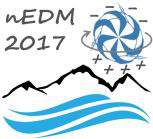Speakers
Emily Altiere
(University of British Columbia)
Eric Miller
(University of British Columbia)
Description
The nEDM (neutron electric dipole moment) project at TRIUMF’s recently established ultra cold neutron (UCN) facility in Canada will introduce a dual co-magnetometer with cohabiting 129Xe and 199Hg for measuring precise magnetic fields within a neutron storage cell. By simultaneously incorporating two atomic species we can deduce both the magnitude and gradient of the magnetic fields, thereby lowering the systematic uncertainties in the nEDM measurement.
Toward this end, the spin precession of polarized 129Xe will be detected by measuring fluorescence intensities following the spin-selective two-photon excitation from the ground 5p6(1S0) state to the excited 5p5(2P3/2)6p state at 252 nm. In order to detect the fluorescence efficiently, the 6p state will be excited by intense 252 nm UV (ultraviolet) radiation created in an enhancement optical cavity. As the first step, we recently observed the fluorescence of the 6p state of Xe atoms excited by 252 nm in an optical cavity. We have used a home-built CW (continuous wave) single-frequency UV laser light source based on an optically pumped semiconductor laser with two resonant frequency doubling cavities. We detected the fluorescence spectrum of the six most abundant isotopes of Xe successfully, with hyperfine resolved peaks for 129Xe and 131Xe isotopes. By calibrating frequencies using a frequency comb, we have determined the hyperfine constants of 129Xe and 131Xe in the 6p(2P3/2) state precisely. In addition, we have analyzed the isotope shift of Xe in the 6p state. We will discuss the analysis of the two-photon excitation spectrum, and our current progress on the measurements of precession of polarized Xe atoms.
| ealtiere@phas.ubc.ca |
Primary authors
Emily Altiere
(University of British Columbia)
Eric Miller
(University of British Columbia)
Co-authors
David Jones
(University of British Columbia)
Kirk Madison
(University of British Columbia)
Takamasa Momose
(University of British Columbia)
Tomohiro Hayamizu
(University of British Columbia)

